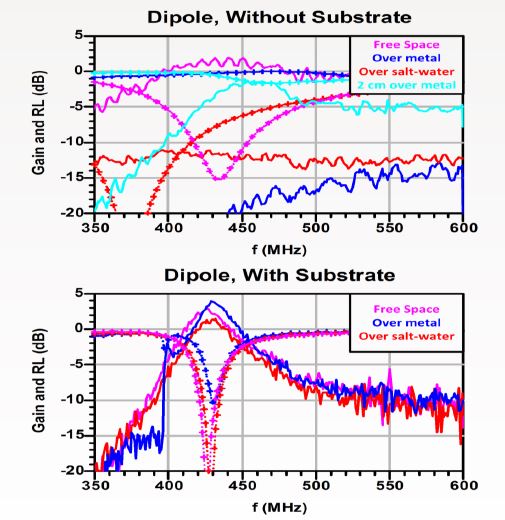The Sandia Wave Reflector
The Sandia wave reflector is a magnetic conductor for wireless transmissions near 433 MHz. The device reflects perpendicular electromagnetic waves in-phase and suppresses surface waves resulting in improved gain performance and effective operation regardless of physical placement. The reflector achieves gain improvement through a quarter-wave short phenomenon. The height of the ceramic rods is electrically equivalent to a quarter-wavelength near 433 MHz. The rods are able to provide this electrical delay in a small form factor due to their high dielectric constant. As an electromagnetic wave travels through the rods along their axes it receives a 1/4 period of phase delay be-fore it reaches the conductive short. The conductive backing reflects electromagnetic waves with a +180° phase, and then the waves travel back through the rods along their axes to receive another 1/4 period of phase delay. This causes the waves to arrive at the antenna surface with a +180° phase and a 1/2 period delay, creating positive interference that effectively doubles the gain of the antenna.
Placement-immunity is achieved in the reflector through surface wave suppression. By preventing surface waves from propagating out of the substrate (perpendicular to the main beam direction), they cannot interact with the surrounding environment and affect the antenna’s performance. Surface wave suppression is achieved through the magnetic dipole resonance of the ceramic rods. When an electromagnetic wave near 433 MHz excites the dielectric rods in the substrate with a transverse electric field polarization, the permeability of the dielectric rods skyrockets at that frequency due to the rod’s resonance. The large permeability of the rods in resonance creates a high impedance surface for the incident electric field, which causes the wave to reflect off of the rod instead of propagating through it.
- Improved return loss
- Gain reinforcement
- Placement immunity– reflector operates effectively regardless of physical placement
- Reduces design time required for antennas needed in various environments
Applications at 433 MHz:
- Voice Communications
- Mobile Robots
- Tracking Devices
- Inventory Reconciliation
- Security Alarms
- Wireless Information Storage

SD #12134
Published10/15/2013
Last Updated10/27/2016